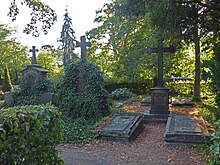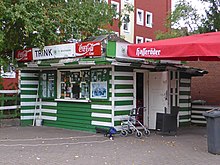Rothenfelde (Wolfsburg)
|
Rothenfelde
City of Wolfsburg
Coordinates: 52 ° 25 ′ 31 ″ N , 10 ° 47 ′ 38 ″ E
|
|
|---|---|
| Residents : | 612 (December 31, 2015) |
| Incorporation : | July 1, 1938 |
| Postal code : | 38440 |
| Area code : | 05361 |
|
Location in Wolfsburg
|
|
|
Schulenburg farm workers' houses in the former Rothenfelde colony
|
|
Rothenfelde is a district not far from the center of Wolfsburg , but it only consists of a few streets. It borders directly on the formerly independent village of Heßlingen .
history
The Rothenfelde settlement was established in the years 1813–35 on the former Sandfeldgraben as a Rothenfelde colony. Count Werner von der Schulenburg-Wolfsburg, lord of the castle in neighboring Wolfsburg , had it built as quarters for farm workers on his manor . Twelve houses were built in a row of streets that bordered the village of Heßlingen .
1902 began test drilling in the district of Rothenfelde. In 1911, Werner-Karl-Hermann Graf von der Schulenburg-Wolfsburg signed a mining contract with Wintershall AG, which allowed Wintershall to carry out mining activities in the Rothenfelde area. Construction of the Rothenfelde union mine began that same year . In 1913, the promotion began in it, it included potash salt for agriculture as well as table salt sold under the Rothenfelder Edelsalz brand . A railway branched off from the Vorsfelde – Fallersleben line and led directly to the mine, the floors were up to 1.5 km long and reached a depth of around 750 meters of the 850-meter-thick salt dome. The Loren were first taken of horses, from 1918 by diesel locomotives. The extracted salt was ground in two raw salt mills. Around 250 to 300 people were employed in the company. In 1925 or 1926 the mine was shut down for economic reasons, from 1927 the winding tower and the buildings above ground were demolished and the shaft filled. The street Schachtweg today reminds of the existence of the mine in this area.
In 1928, the Rothenfelde-Wolfsburg station was opened outside of the built-up area on the railway line that had already been opened around 1872 . It was later renamed Wolfsburg and remained in operation until the provisional commissioning of today's Wolfsburg main station in 1956, after which it was demolished.
On July 1, 1938, the Rothehof-Rothenfelde community was dissolved and merged into the newly founded town of the KdF-Wagen , today's Wolfsburg. Barracks were built to the west of the old town.
In the 1950s, the area to the west of the old local area was rebuilt, and mainly smaller businesses emerged. The customs office was built there in the 1960s . In 1963 the inn was demolished, it was located on the northern outskirts and since 1938 has been called Zur gute Quelle .
Today's Rothenfelde district consists of the "Rothenfelder Markt" (formerly the Rothenfelde colony) and the adjacent streets in the direction of Porschestrasse . Numerous modern buildings have been built here, which contrast with the old Rothenfelde.
politics
Together with the neighboring districts of Hellwinkel , Heßlingen , Köhlerberg , Schillerteich , Stadtmitte and Steimker Berg, Rothenfelde forms the town center, which is represented by a local council. Detlef Conradt (SPD) is the local mayor .
Culture and sights
- Rothenfelde Colony
- Model of the village of Rothenfelde in the restaurant of the Centro Italiano in neighboring Heßlingen . It shows the state of Rothenfelde in 1899.
- Grave site of the von der Schulenburg- Wolfsburg family in the cemetery with gravestones from the years 1861 to 1976. The oldest grave monument is of Friedrich Gebhard Werner Graf von der Schulenburg-Wolfsburg, the founder of the Rothenfelde colony.
- Pump room from the 1950s, one of the last surviving kiosk building in Wolfsburg. After VfL Wolfsburg was promoted to the 2nd Bundesliga in 1992/93 , the drinking hall was painted green and white in 1993, the club colors of VfL Wolfsburg. In August 2020, despite various rescue efforts, the pump room was torn down to make space for parking spaces.
literature
- Wolfsburg. The architecture guide. 1st edition 2011, ISBN 978-3-03768-055-1 . P. 24
- City of Wolfsburg, Institute for Museums and City History (Ed.): Wolfsburg Castle - History and Culture. Wolfsburg 2002, ISBN 3-930292-62-9 , pp. 156, 160
- Lieselotte Kuchenbecker: Unequal neighbors. In: Wolfsburg - our city. Wolfsburg 1963, pp. 44-46
To the potash shaft
- Herbert Roscher: "Rothenfelder Edelsalz". In: Wolfsburg our city. Wolfsburg 1963, pp. 90-92.
- Adolf Köhler: Wolfsburg. A chronicle. 1938-1948. Wolfsburg 1974, pp. 41-42.
- Fritz Hesse: Wolfsburg, yesterday and today. 2nd edition, Wolfsburg 1968, pp. 11-13.
- Willi Schulz: Wolfsburg, the center of a changing landscape. Wolfsburg 1969, pp. 44-46.
Web links
Individual evidence
- ↑ Main statute of the city of Wolfsburg of November 2, 2016 (PDF) (for localities and local councils see § 9 of the main statute)
- ↑ Hans Karweik: Giovanni on television. In: Wolfsburger Nachrichten. Edition of October 2, 2017.
- ↑ Hendrik Rasehorn: Zapfenstreich - cult kiosk is demolished. In: Wolfsburger Nachrichten. Edition of August 15, 2020.



